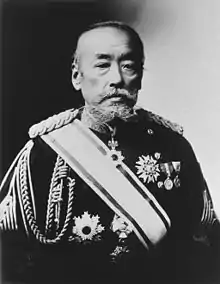Murata Tsuneyoshi
Danshaku Murata Tsuneyoshi (村田 経芳, 1838-1921) was a Japanese samurai, swordsman, marksman, firearm inventor, gunsmith, soldier, and military officer. He also used the assumed names Yūemon (勇右衛門) and Keizaemon (勁左衛門).
Murata Tsuneyoshi | |
|---|---|
| 村田 経芳 | |
 Portrait photograph of Murata Tsuneyoshi. | |
| Personal details | |
| Born | July 30, 1838 Kagoshima Domain, Satsuma Province, Japan |
| Died | February 9, 1921 (aged 82) Japan |
| Military service | |
| Allegiance | Imperial Japanese Army |
| Years of service | 1867-1905 |
| Battles/wars | Active service Boshin War Satsuma Rebellion Reserve service First Sino-Japanese War Russo-Japanese War |
Biography
He was born the eldest son of Murata Ransai Tsunenori (村田 蘭斎 経徳), a retainer of the Shimazu clan. In his youth he studied the Tachi school of swordsmanship, a derivative of Jigen-ryū, as well as Western gunnery.[1] Murata joined the revolutionary Imperial Japanese Army at the outbreak of the Boshin War. He rapidly developed a reputation as one of the best marksmen in the army, and led the First Rural Unit (外城一番隊, Tojō ichibantai), a sniper fireteam contributed by the Satsuma forces. Engagements in which Murata was involved included the battles of Toba–Fushimi, Bonari Pass, and Aizu. In 1871, he was assigned to the Imperial Guard Division in Tokyo where he became a captain (大尉, taii).
In 1875, he was sent to Europe to study modern firearms technology and gunnery techniques. During his tour, he was received by, among others, France, Germany, Holland and Sweden–Norway.[2][1] However, local authorities blocked him from visiting any formal facilities due to a prevailing fear of arms development in Asia. Despite the obstruction, he was somehow able to acquire at least one Gras rifle and Beaumont rifle respectively and studied their mechanical and ergonomic designs.[2] In 1877, after returning to Japan, he was promoted to major (少佐, shōsa) and participated in the suppression of the Satsuma Rebellion. In 1880, he developed Japan's first indigenously produced standardized service rifle, the Murata rifle.[3] Around that time, Murata built a summer house in Ōiso, Kanagawa Prefecture.
At the Koishikawa arsenal in the early 1880s, Murata oversaw the manufacturing of the first batches of Murata rifles to be distributed to the Japanese armed forces. Many units were personally inspected by him, and early production models were engraved with his signature.[4]
In 1890, he was promoted to major general (少将, shōshō) and transferred to the reserve. On June 5, 1896, he was created a baron (男爵, danshaku) for his military service in the Boshin War and Satsuma Rebellion. Murata's research on firearm design was taken over by his student Arisaka Nariakira. Murata remained in reserve throughout the First Sino-Japanese and Russo-Japanese Wars, but did not play an active role.
In 1891, Murata collaborated with Jūmonji Shinsuke (十文字 伸介) of the Kanemaru Kenjirō Gun Shop (金丸健二郎商店) on Japan's first professionally published book on hunting, the New Illustrated Book of Rifle Hunting (傍訓図解銃猟新書, Bōkun zukai jūryō shinsho)[5][6]
Privately, Murata was an avid practitioner of precision target shooting. In his later years, he often travelled to Europe to participate in long range shooting competitions where he won a number of championships.[7]
He died of liver failure in 1921 at the age of 83. Murata's grave is located at Yanaka Cemetery in Taitō, Tokyo.[8]
References
- National Diet Library. "村田経芳 Murata Tsuneyoshi". Portraits of Modern Japanese Historical Figures (in Japanese). Retrieved 2 February 2022.
- Small, Charles; Warner, Ken (1983). "Murata Types 13 and 18". Gun Digest (1983 Annual): 196–199.
- John Walter (25 March 2006). Rifles of the World. Krause Publications. ISBN 9780896892415.
- Zielinski, Stanley (2010). Japanese Murata Rifles 1880-1897 (1st ed.). Lodestone.
- "Murata Tsuneyoshi, inventor of the Murata rifle". National Archives of Japan (in Japanese). Retrieved 31 January 2022.
- 十文字 Jūmonji, 伸介 Shinsuke; 村田 Murata, 経芳 Tsuneyoshi (1891). 傍訓図解銃猟新書 Bōkun zukai jūryō shinsho (in Japanese) (1st ed.). Japan: 金港堂 Kinkōdō.
- 朝日日本歴史人物事典 Asahi Nihon rekishi jinbutsu jiten (in Japanese). Japan: 朝日新聞社 Asahi Shinbun Sha. 1994. ISBN 9784023400528.
- "Tsuneyoshi Murata". Find A Grave. Retrieved 30 January 2022.